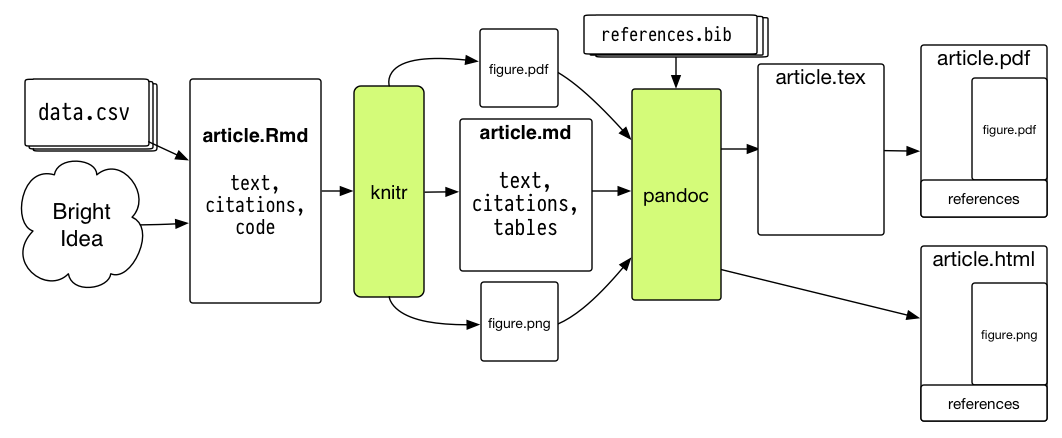6.7 KiB
Executable file
| type | title |
|---|---|
| page | Resources |
Code and Data
This page has links to configuration files, templates, and a few other things that might be of use to people who want to write well-formatted social science papers in plain text, with data, figures, and references.

The Plain Person's Guide to Plain Text Social Science →
As a beginning graduate student in the social sciences, what sort of software should you use to do your work? More importantly, what principles should guide your choices? This article offers some answers. The short
version is: you should use tools that give you more control over the process of data analysis and writing. I recommend you write prose and code using a good text editor; analyze quantitative data with R or Stata; minimize
error by storing your work in a simple format (plain text is best), and make a habit of documenting what you've done. For data analysis, consider using a format like Rmarkdown and tools like Knitr to make your work more
easily reproducible for your future self. Use Pandoc to turn your plain-text documents into PDF, HTML, or Word files to share with others. Keep your projects in a version control system. Back everything up regularly. Make
your computer work for you by automating as many of these steps as you can. To help you get started, I briefly discuss a drop-in set of useful defaults to get started with Emacs (a powerful, free text-editor). I share
some templates and style files that can get you quickly from plain text to various output formats. And I point to several alternatives, because no humane person should recommend Emacs without presenting some other options
as well. There is a sample github repository that contains the .md source file the PDF is created from. This material is also available as a website at http://plain-text.co.
An Emacs Starter Kit for the Social Sciences
This is a fork of Eric Schulte's Emacs Starter Kit (itself an offshoot of Phil Hagelberg's original) with additional tools included for social scientists, mostly related to writing books or papers in LaTeX and analyzing quantitative data using ESS and R. The goal is to provide a drop-in configuration for Emacs that makes it easier to use right from the get-go. If you know about Git, you can clone the repository.
<h4><a href="http://vissoc.co">Data Visualization Course Notes</a> →</h4>
<p>Notes, links, and code from a Data Visualization short-course I taught in the Fall of 2015. The course is focused on the practical presentation of real data, mostly using R's `ggplot2` library. We also read some
material on principles of data visualization, in order to help develop a good working sense of why some graphs and figures work well while others either fail to inform or actively mislead.
LaTeX Templates and Styles →
A collection of LaTeX style files, templates, and org-mode documents providing some nice layouts for typesetting articles using pdfLaTeX or XeLaTeX. They make a pipeline that lets you begin with an
.org file in Emacs (as set up in the Starter Kit), and go from there to a nice, fully-processed PDF in one step. Or the pieces can be used separately
to set up a .tex file with a nice Article layout.
Pandoc Templates →
Some Pandoc templates meant to go in ~/.pandoc/templates. Point to them directly with the --template or --css switches as appropriate, and use them with what's provided in latex-custom-kjh. Includes a shell script for setting pandoc up to work with the Marked app, a handy HTML live
previewer for .md files.
So You Like My Vita →
Every few months I get an email asking to see the LaTeX markup that I use to generate my Curriculum Vitae. So, here it is. Feel free to adapt it yourself. If you make stylistic modifications, I encourage you to fork the project on GitHub and make them available to others in the same way.
So You Like My Website →
This site is produced using Hugo, a very fast static site generator, which you can read more about here. I've written about my own experience setting it up, too. The design is borrowed mostly from Greg Restall. If you want to look under the bonnet, the entire site is on GitHub. Feel free to adapt it yourself. If you make stylistic modifications, I encourage you to fork the project on GitHub and make them available to others in the same way. You should also change the Google Analytics information in the footer partial, or I will receive analytics information about your site.
<h4><a href="/resources/github/">All GitHub Projects</a></h4>
<p>Here is a <a href="/resources/github/">full list of the various public code and data repositories</a> that I have put on GitHub. They range from the configuration and templating tools listed above to data
visualization exercises and other bits of data analysis, mostly written in R.